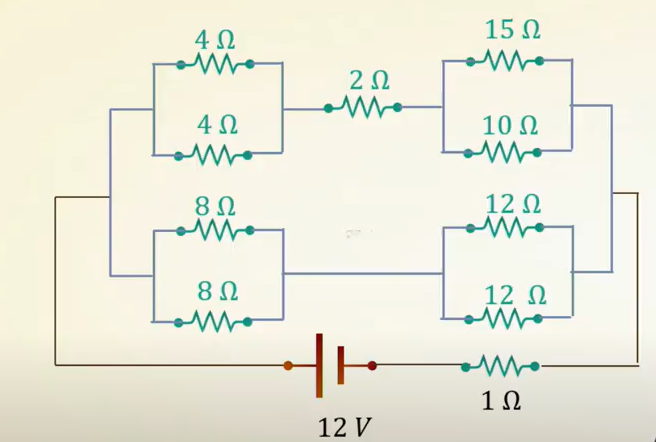A resistance of 6 ohms is connected in series with another resistance of 4 ohms. A potential difference of 20 volts is applied across the combination. Calculate the current through the circuit and potential difference across the 6 ohm resistance.
The first step in solving such problems based on current electricity is to draw a proper circuit diagram. For example, in this problem we have two resistances of 6 ohms and 4 ohms which are connected in series. So, first of all we have to draw these two resistances on paper as shown in Figure alongside. Now, a potential difference of 20 volts has been applied across this combination of resistances. So, we draw a cell or a battery of 20 volts and complete the circuit as shown in Figure alongside. Suppose the current flowing in the circuit is I amperes.
We will now find out the value of current I flowing through the circuit. To do this we should know the total resistance R of the circuit. Here we have two resistance of 6Ω and 4Ω connected in series. So,
Total resistance, R=R1+R4
R=6+4
R=10 ohms
Now, Total resistance, R=10 ohms
Potential difference, V=20 volts
and, Current in the circuit, I=? (To be calculated)
So, applying Ohm's law to the whole circuit, we get:
VI=R
So that, 20I=10
And, 10I=20
I=2010
So, Current, I=2 amperes (or 2A)
Thus, the current flowing through the circuit is 2 amperes. The second part of this problem is to find out the potential difference across the ends of the 6 ohms resistance. To do this we will have to apply Ohm's law to this resistance only. We know that the current flowing through the 6 ohm resistance will also be 2 amperes. Now,
Potential difference (across 6Ω resistance), V=? (To be calculated)
Current (through 6Ω resistance), I=2 amperes
And, Resistance, R=6 ohms
So, applying Ohm's law to the 6Ω resistance only, we get:
VI=R
or V2=6
So, Potential difference, V=12volts
Thus, the potential difference across the 6 ohm resistance is 12 volts.

Topper's Solved these Questions
- ELECTRICITY BOOK - LAKHMIR SINGH & MANJIT KAURCHAPTER - ELECTRICITY EXERCISE - Sample Problem
1 Videos
- ELECTRICITY BOOK - LAKHMIR SINGH & MANJIT KAURCHAPTER - ELECTRICITY EXERCISE - Exercise
311 Videos
- MAGNETIC EFFECT OF ELECTRIC CURRENT BOOK - LAKHMIR SINGH & MANJIT KAURCHAPTER - MAGNETIC EFFECT OF ELECTRIC CURRENT EXERCISE - NCERT BOOK
2 Videos
Similar Questions
Knowledge Check
Find current through 4ohm resistance
 A1AmpB2AmpC3AmpD4Amp
A1AmpB2AmpC3AmpD4AmpIf a potential difference of 1 volt applied across the conductor causes a current of 1 ampere to flow through, it then the resistance of a conductor is a
AohmBsiemenCfaradDhenryA 2-A current flows through a resistor when a potential difference of 20 V is applied across it. The resistance of the resistor is
A2ΩB1ΩC10ΩD20Ω
Find potential across 15ohms resistance.

View SolutionA potentail difference of V=(20±1) volt is applied across a resistance of (8.0±2) ohm. Calculate the current with error limits.
View SolutionA potential difference of 250 volts is applied across a resistance of 500 ohms in an electric iron. Calculate (i) current, and (ii) heat energy produced in joules in 10 seconds.
View SolutionAn electric lamp whose resistance is 8 Ω and a conductor of 2 Ω resistance are connected in series to a 5 volt battery . Calculate( a) the total resistance of the circuit (b) the current through the circuit (c) the potential difference across the electric lamp and the conductor?
View SolutionA resistance of 20 ohms has a current of 2 amperes flowing in it. What potential difference is there between its ends?
View Solution

